Abstract
In recent years, active noise control (ANC) systems have been widely used in advanced electronic appliances. Nowadays, several authors use gradient-optimization algorithms since they can be easily implemented in these devices. However, these algorithms need to estimate the secondary path in advance. As consequence, this factor can limit its use in real-ANC applications since the secondary path can undergo significant variations over time. To solve this problem, we propose an ANC system with switching filter selection based on particle swarm optimization (PSO) algorithms. Specifically, we use two sets of populations of particles with different acceleration coefficients and inertia weights to create an advanced structure in which the first PSO algorithm guarantees a high convergence speed while the use of the second PSO algorithm allows to achieve a high-level noise reduction. The results demonstrate that the proposed algorithm exhibits better convergence properties compared with previously reported solutions.
1. Introduction
Nowadays, environmental noise represents a worldwide health problem. Specifically, this noise is increased significantly due to the use of industrial equipment (motors, fans, extractors, transformers), means of transport (automotive vehicles, airplanes, etc.), among others. As consequence, the environmental noise critically affects the acoustic environment of houses, buildings, hospitals, offices, schools. During the last decades, ANC systems have emerged as a possible solution to solve the problem of environmental noise [1,2]. In general, ANC is conceived as a technique that employs adaptive filters to generate an anti-noise signal, which attenuates the noise signal by means of the principle of superposition, as shown in Figure 1. In conventional ANC systems, several authors have used gradient-optimization filtered-X least mean square (FXLMS) algorithms since these algorithms exhibit low computational complexity [3]. As a consequence, these algorithms are easy to implement in embedded devices [4,5,6,7]. However, these algorithms exhibit a low convergence speed, which reduces the performance of the ANC systems in terms of noise cancellation. To face these problems, several authors have proposed advanced convex combination filtering structures [8,9,10,11,12,13]. In these structures, two filters with complementary capabilities are used to improve the overall filter performance in comparison when a single filter is used. Commonly, in these combinations, the authors use a first filter with a large step-size to offer fast convergence speed. To guarantee low steady-state mean square error (MSE) a second filter with small step-size is used. However, these structures present a high computational cost since two filters are used at the same time. On the other hand, the performance of these algorithms in real acoustic environments can be affected critically due to two factors: (1) estimation of the secondary path; (2) time-variations of the secondary path. For example, if the estimated model of the secondary path is not accurate, the ANC systems presents instability [14,15,16,17]. Therefore, this aspect has a big impact, especially in practical situations, since some studies have demonstrated that secondary path can change over the time. On the other hand, the adaptability of the most commonly used off-line estimation methods is null when variations of the secondary path occur.
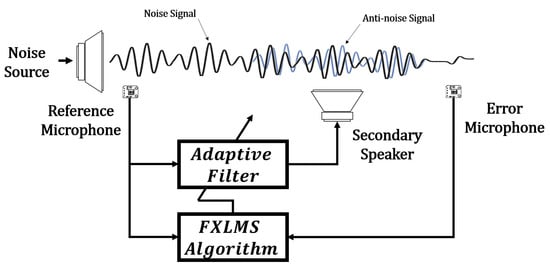
Figure 1.
Block diagram of the conventional FXLMS-based ANC system.
Some studies have demonstrated that a genetic algorithm (GA) can be applied to ANC systems [18,19,20,21,22]. However, it exhibits slow convergence and it requires many operations [23]. Recently, several authors have proposed the use of bio-inspired algorithms to overcome these problems. Specifically, particle swarm optimization (PSO) algorithm has demonstrated its highly computational capabilities for online ANC adaptation. Specifically, the existing PSO-based ANC systems are mainly composed of P adaptive filters to minimize the noise signal by generating an antinoise signal, as shown in Figure 2. In a PSO-based ANC system, the noise source, which travels via primary path, is obtained by the reference microphone. Once the source is captured, this signal is sent to one of the P adaptive filters [23,24]. After performing the adaptive filtering process, the output is sent to the loudspeaker to generate the antinoise signal. In addition, the ANC system employs the error microphone to sense the residual noise. Here, this noise is processed by P adaptive filters to adjust their weights at each generation, where a generation is defined as a time to perform swarming operations.
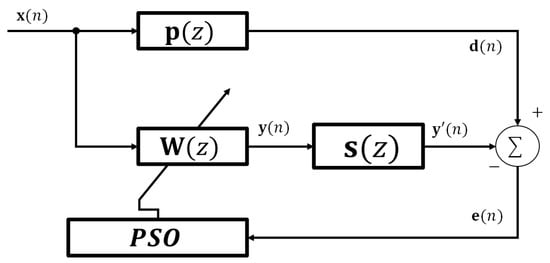
Figure 2.
Block diagram of the conventional PSO-based ANC system.
As mentioned above, diverse PSO-based ANC systems have been proposed to improve the noise cancelation. For example, in [23] presented a conditional reinitialization of the particle vectors of the PSO algorithm to process time-varying plants of the ANC systems. Specifically, the authors intend to improve the convergence properties, specially when abrupt changes in primary and/or secondary paths occurs since the conventional PSO is ineffective to regain convergence under these conditions. Another work was presented in [25], in which a functional-link-artificial-neural-network-based (FLANN) multichannel nonlinear ANC system is trained by a PSO algorithm. In [26], the authors evaluated the performance of an ANC system by using the PSO algorithm and Wilcoxon norm. In [27], presented an adaptive narrowband ANC system based on PSO algorithm. Specifically, their approach avoids the use of a synchronization signal. In [28], the PSO algorithm is used to attenuate engine noise inside vehicle enclosures. Therefore, these approaches intend to solve problems related to time-variations of the path, multi-channel ANC systems, nonlinear ANC systems. Recently, in [24] presented a new variant of the quantum-behaved PSO algorithm. This approach intends to decrease its computational complexity and improve the noise reduction level. However, this approach achieves a slight improvement in terms of noise reduction level compared with existing approaches. It should be noted that the noise reduction level is one of the most important factor to be considered since it determines the efficiency of noise cancellation. Therefore, a big challenging task is the development of an efficient PSO-based ANC system which can efficiently reduce the noise and it can be seen as a prominent solution in real-world ANC applications.
2. Proposed PSO-Based ANC System with Switching Filter Selection
Inspired by convex combination structures based on gradient descent algorithms [8,9,10,11,12,13], we present a new variant of the PSO-based ANC structure. Specifically, we introduce for the first time an ANC structure, in which two PSO algorithms are used, to significantly improve the convergence properties. As a consequence, the proposed structure can be used in real acoustic environments. Here, each PSO algorithm has been parameterized under different acceleration coefficients and inertia weights to create a global filter whose performance is better than the PSO-based ANC systems. During the last years, several studies have demonstrated that the convergence behavior of PSO algorithm is determined by the values of the inertia weight and the acceleration coefficients [29,30,31]. Although PSO algorithm is considered to be robust in many applications, it fails to find a balance between exploration and exploitation processes [32].
As can be observed from Figure 3, we use two PSO algorithms to create a new PSO-based ANC system. The first algorithm is dedicated to perform an efficient exploration process by providing a high convergence speed, while the second algorithm is used to efficiently perform the exploitation process by offering a low steady-state MSE. To control the selection between these two algorithms, we employ a selection criteria based on the evaluation of past samples of the error signal . In this way, we evaluate the degree of change of the error signal over time. The use of these strategies have allowed us to create a PSO-based adaptive filter with switching filter selection to improve convergence properties compared with existing approaches.
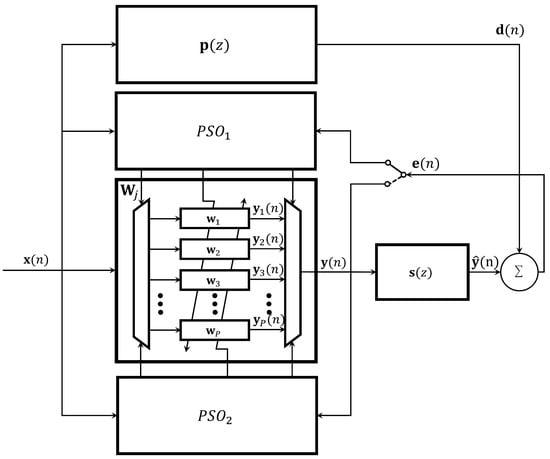
Figure 3.
Structure of the proposed PSO-based ANC system with switching filter selection.
Figure 4 shows the control process to perform the proposed PSO-based ANC system by executing the following steps:
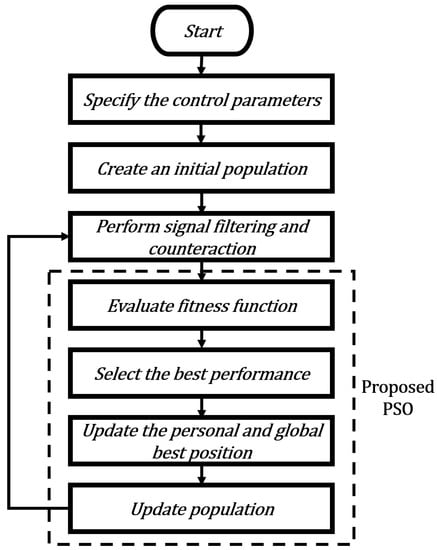
Figure 4.
Flowchart of the proposed PSO-based ANC system with switching filter selection.
- Specify the control parameters. Here, the PSO-based ANC system is composed of j population matrices , where each matrix is composed of P adaptive filters and each particle represents an adaptive filter, as shown in Equation (1). Therefore, the order N of each adaptive filter defines the dimension of each particle. The whole population is defined as follows:where is the parameter to select between and .
- Create an initial population. At the first iteration , the position of each particle is initialized for both populations, where .where is a gaussian process of length with zero mean and variance = 0.25. The values is a lower bound and is a upper bound, since the impulse response of the primary path is normalized.
- Perform signal filtering and signal counteraction. The signal travels via primary path to generate the signal . In addition, the signal is processed by the PSO algorithm to update its coefficients. Here, each particle is used to compute a single filter at any generation time n. Once the coefficients are updated, signal is produced and it travels via the secondary path to generate the anti-noise signal . On the other hand, the calculation of signal counteraction or also called residual noise is given by
- Evaluate fitness function. The mean squared error (MSE) of each P error signal, which represents the fitness function of each adaptive filter, is used by two PSO algorithms to determine the best position. Here, the fitness value of the position can be obtained as follows:where T depicts the total number of iterations
- Select the best performance. As can be observed from Figure 3, the proposed ANC system is composed of two PSO algorithms ( and ). Here, each particle of the PSO algorithms has a position and a velocity . Equations (5) and (6) are used to update these parameters as follows:where and are the acceleration coefficients, and are the vectors of random numbers of length N, and are the personal best position and global best position, respectively, and is the inertia weight. In addition, and are defined in the interval [0, 1] and the inertia weight can be obtained as follows:To select between two PSO algorithms ( and ), we propose a selection criteria based on the evaluation of past samples of the error signal to verify significant changes in the MSE level. Equations (8) and (9) are used to evaluate the past samples of the error as follows:Hence, the updates of the position and velocity of each PSO algorithm are ruled by the following equations:where , is a small number close to zero, and is chosen by trial and error [23]. In general, Equations (10) and (12) indicate when the PSO algorithms are updated. If the degree of change of the MSE level is larger than , the algorithm must be updated and transfer its coefficients to the allowing the system to update only one algorithm at a time. On the other hand, if according to Equation (12), must be updated, the new coefficients are transferred to . With the proposed scheme, a fast convergence speed using algorithm is attained, and the MSE level is reduced by employing algorithm.
- Update the personal and global best position. In this step, two variables are selected, the first one is called personal best position, . To find the value of , we perform a comparison between the current value of and the value of as follows:To compute Equation (14) at the first generation, the is defined as . The second variable is denominated as global best position, . To calculate this variable, we compare the result of with the evaluation of the best global position , where , . The computation of the global best position, is given by
In general, algorithm is responsible of performing the exploration task. Once the adaptive filter reaches the steady-state, the algorithm executes the exploitation tasks to achieve a high noise reduction.
3. Simulation Results
Here, we simulate the proposed PSO-based ANC system (single channel) with switching filter selection in MATLAB to demonstrate its effectiveness in terms of convergence properties. Specifically, we develop a set of simulation experiments under the following conditions:
- 1.
- We model the primary and secondary paths as finite impulse response (FIR) filters using 256 and 128 coefficients [33], respectively.
- 2.
- The MSE was evaluated at error microphones.
- 3.
- We consider a white Gaussian noise signal with a zero mean as input signal .
- 4.
- Table 1 shows the selected acceleration coefficients and inertia weights to produce the best convergence properties. As is well known, acceleration coefficients are static. Therefore, the optimal values need to be found empirically. In general, the use of low values for and produces smooth particle trajectories [34]. Here, the proper selection of these values have allowed the particles to roam close from good regions which produces more acceleration. Based on [34], we select of the inertia weights () and values for and , as follows:
 Table 1. Acceleration coefficients and inertia weights used in all experiments.According to previous equation, if the condition is not satisfied, the PSO algorithm may diverge or could present cyclic behavior.
Table 1. Acceleration coefficients and inertia weights used in all experiments.According to previous equation, if the condition is not satisfied, the PSO algorithm may diverge or could present cyclic behavior.
To validate the performance of the proposed algorithm, we made a comparison between this bio-inspired algorithm and the conventional FXLMS algorithm. In addition, we carried out several experiments by varying the filter’s order, number of particles and changing the secondary/primary path during the filtering process to validate the performance of the proposed PSO-based ANC system.
- Comparison between the proposed algorithm and the FXLMS algorithm. To evaluate the MSE level, we use a population of 100 particles. To verify the tracking capabilities of the algorithms, we induce an abrupt change in the middle of the generations (1500) by multiplying the secondary path by −1. The FXLMS step-size was adjusted by trial and error; the value producing the fastest convergence speed was selected.As can be observed from Figure 5, the proposed algorithm exhibits higher convergence speed when compared to the conventional FXLMS. Besides, the FXLMS requires an estimation of the secondary path to avoid instability and low accuracy. In contrast, this estimation is not required when the PSO algorithm is used.
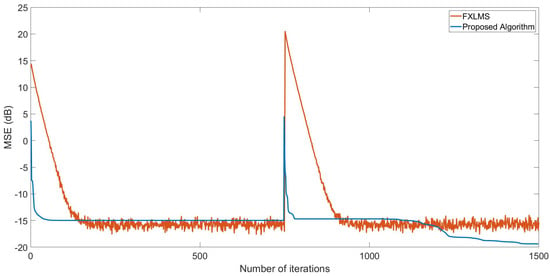 Figure 5. Learning curves of the proposed PSO-based ANC algorithm and the FXLMS algorithm.
Figure 5. Learning curves of the proposed PSO-based ANC algorithm and the FXLMS algorithm. - Effect of changing the order of adaptive filter. To evaluate the MSE level, we use a population of 100 particles and different adaptive filter’s length (N from 20 to 50), as shown in Figure 6. To verify the tracking capabilities of the proposed PSO-based ANC system, we induce an abrupt change in the middle of the generations (1500) by multiplying the secondary path by −1. As can be observed from Figure 6, the MSE level is high when low number of coefficients are used. Otherwise, the use of large number of coefficients improves the MSE level by paying a penalty in terms of convergence speed. In addition, the use of high order adaptive filters demands a high computational cost by improving significantly the MSE level, where this parameter is crucial in practical ANC systems since it determines the level of noise reduction.
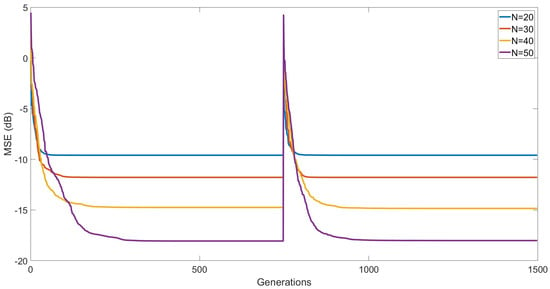 Figure 6. Learning curves of the proposed PSO-based ANC system for different filter lengths N using 100 particles.
Figure 6. Learning curves of the proposed PSO-based ANC system for different filter lengths N using 100 particles.
- Effect of changing the number of particles of the PSO algorithm. According to previous results, we obtained the higher level reduction when 50 filter coefficients are used. When selecting a number higher than 50, the performance of the algorithm does not change and remains the same. Therefore, in this experiment, we use this number of filter coefficients and vary the number of particles to verify how the performance of the proposed PSO-based ANC system is affected. As can be observed from Figure 7, the number of particles is an important factor to be considered, especially when high level of noise reduction and fast convergence speed are required. Hence, the use of a large number of particles and high order filters guarantees good convergence properties at the cost of increasing the computational complexity.
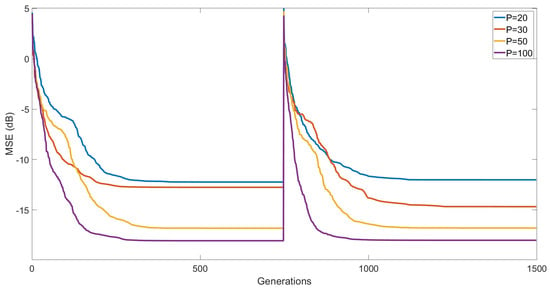 Figure 7. Learning curves of the proposed PSO-based ANC system for different number of particles P using 50 filter coefficients.
Figure 7. Learning curves of the proposed PSO-based ANC system for different number of particles P using 50 filter coefficients.
- Comparison between the proposed PSO-based ANC system with switching filter selection and existing approaches. In addition to previous simulations, we simulate the proposed PSO-based ANC system and existing approaches [23,24] to make a consistent comparison between them in terms of the MSE level. Table 2 shows the fixed parameters of the existing approaches, such as acceleration coefficients and inertia weights, which were selected to provide the best performance of these approaches. Here, the primary and secondary path of the proposed PSO-based ANC system and existing approaches were multiplied by −1 at generation 750 to test their tracking behavior, as shown in Figure 8 and Figure 9, respectively. As can be observed, the proposed PSO-based ANC system achieves a higher MSE level when compared with existing approaches. It should be noted that the most recent approach based on quantum-behaved (QPSO-based ANC system) [24] achieves a slight improvement of the MSE level compared with the PSO-based ANC system [23] at the cost of increasing its computational complexity, as shown in Table 3. As can be observed, the proposed PSO-based ANC system with switching filter selection reaches similar convergence speed compared with the QPSO-based ANC system. However, the proposed approach exhibits better MSE-level by expending lower computational cost. On the other hand, we include the FXLMS algorithm in the comparison. Obviously, the FXLMS algorithm exhibits lower computational cost compared with the existing bio-inspired approaches. Nonetheless, the FXLMS algorithm presents the lowest convergence speed.
 Table 2. Acceleration coefficients and inertia weights of the PSO and QPSO algorithms.
Table 2. Acceleration coefficients and inertia weights of the PSO and QPSO algorithms.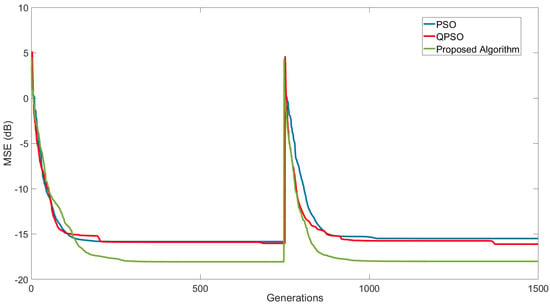 Figure 8. Comparison between approaches when a change in the primary path occurs.
Figure 8. Comparison between approaches when a change in the primary path occurs. Figure 9. Comparison between approaches when a change in the secondary path occurs.
Figure 9. Comparison between approaches when a change in the secondary path occurs. Table 3. Comparison between the proposed PSO-based ANC system and existing approaches [23,24,35] in terms of computational complexity.
Table 3. Comparison between the proposed PSO-based ANC system and existing approaches [23,24,35] in terms of computational complexity.
- Power Spectrum analysis. Apart from previous results, we obtained the residual noise at the error microphone by using two different reference signals. Figure 10 depicts the residual noise and the power spectrum when a multi-tonal signal is used as undesired-noise. As can be observed from this figure, if the adaptation process occurs, the noise at the error microphone decreases.
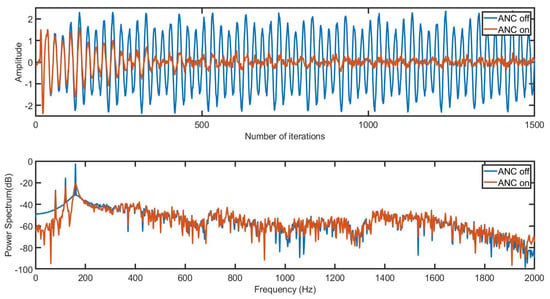 Figure 10. Residual noise and power spectrum of the error signal at error microphone by processing a multi-tone signal as reference signal.Figure 11 depicts the residual noise and the power spectrum when a broadband noise is used as undesired-noise. As can be observed from Figure 11, the proposed algorithm achieves an average noise reduction of 11.54 dB by using broadband noise as a reference signal.
Figure 10. Residual noise and power spectrum of the error signal at error microphone by processing a multi-tone signal as reference signal.Figure 11 depicts the residual noise and the power spectrum when a broadband noise is used as undesired-noise. As can be observed from Figure 11, the proposed algorithm achieves an average noise reduction of 11.54 dB by using broadband noise as a reference signal.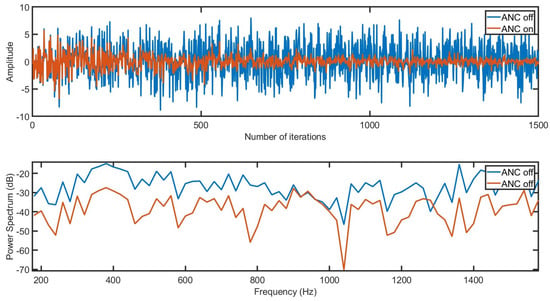 Figure 11. Residual noise and power spectrum of the error signal at error microphone by processing a broadband noise as reference signal.
Figure 11. Residual noise and power spectrum of the error signal at error microphone by processing a broadband noise as reference signal.
4. Conclusions
In this brief, we introduce for the first time a PSO-based ANC structure, in which two PSO algorithms are used. Here, these algorithms are initialized with different parameters and involves a selection criteria to create an ANC filtering structure to significantly improve the convergence properties in comparison with existing approaches. Therefore, we present two contributions:
- 1.
- We take advantage of the complementary capabilities of two PSO algorithms to improve the MSE level.
- 2.
- We propose a selection criteria to determine which PSO algorihm is used. Therefore, both algorithms are not executed at the same time during the whole adaptive processing. In this way, we intend to decrease the computational cost of the proposed ANC system since two algorithms are used. However, the proposed filtering scheme has a significantly improved steady-state MSE level.
Our experiments have demonstrated that the proposed PSO-based ANC filtering structure can regain convergence when abruptly changes occurs in the primary and secondary paths. Here, we use large paths, in contrast to previous studies [23,24], to recreate real acoustic environments which will potentially lead to the development of practical ANC applications in near future [36].
Author Contributions
Conceptualization, G.S. (Gabriel Sánchez) and J.C.S.; methodology, J.G.A. and G.S. (Giovanny Sánchez); software, E.P. and E.A.; validation, E.P. and E.A.; formal analysis, E.V. and G.S. (Giovanny Sánchez); investigation, J.G.A. and A.V.; resources, E.V. and A.V.; data curation, H.M.P.; writing—original draft preparation, H.M.P.; writing—review and editing, H.M.P.; supervision, G.S. (Gabriel Sánchez) and G.S. (Giovanny Sánchez); funding acquisition, J.G.A. All authors have read and agreed to the published version of the manuscript.
Funding
The authors would like to thank the Instituto Politécnico Nacional for the financial support.
Acknowledgments
The authors would like to thank the Consejo Nacional de Ciencia y Tecnologia (CONACYT) and the IPN for the financial support.
Conflicts of Interest
The authors declare no conflict of interest.
References
- Lu, L.; Yin, K.L.; de Lamare, R.C.; Zheng, Z.; Yu, Y.; Yang, X.; Chen, B. A survey on active noise control in the past decade–Part II: Nonlinear systems. Signal Processing 2021, 181, 107929. [Google Scholar] [CrossRef]
- Kajikawa, Y.; Gan, W.S.; Kuo, S.M. Recent advances on active noise control: Open issues and innovative applications. APSIPA Trans. Signal Inf. Processing 2012, 1, e3. [Google Scholar] [CrossRef] [Green Version]
- Kuo, S.M.; Morgan, D.R. Active noise control: A tutorial review. Proc. IEEE 1999, 87, 943–973. [Google Scholar] [CrossRef] [Green Version]
- Belicchi, C.; Opinto, A.; Martalo, M.; Tira, A.; Pinardi, D.; Farina, A.; Ferrari, G. ANC: A Low-Cost Implementation Perspective; SAE International: Warrendale, PA, USA, 2022; No. 2022-01-0967. [Google Scholar]
- Sun, G.; Feng, T.; Li, M.; Lim, T.C. Convergence analysis of FXLMS-based active noise control for repetitive impulses. Appl. Acoust. 2015, 89, 178–187. [Google Scholar] [CrossRef]
- Ryu, K.W.; Hong, C.S.; Jeong, W.B. Active noise control of closed rectangular cavity using the fxlms algorithms. In Proceedings of the Korean Society for Noise and Vibration Engineering Conference, Jeju Island, Korea, 23–25 October 2009; pp. 247–249. [Google Scholar]
- Sanchez, G.; Diaz, C.; Avalos, J.G.; Garcia, L.; Vazquez, A.; Toscano, K.; Sanchez, J.C.; Perez, H. A highly scalable parallel spike-based digital neuromorphic architecture for high-order fir filters using lms adaptive algorithm. Neurocomputing 2019, 330, 425–436. [Google Scholar] [CrossRef]
- Vazquez, A.A.; Avalos, J.G.; Sanchez, G.; Sanchez, J.C.; Perez, H. A Comparative Survey of Convex Combination of Adaptive Filters. IETE J. Res. 2020, 1–11. [Google Scholar] [CrossRef]
- Vázquez, A.; Pichardo, E.; Avalos, J.G.; Sánchez, G.; Martínez, H.M.; Sánchez, J.C.; Pérez, H.M. Multichannel active noise control based on filtered-x affine projection-like and LMS algorithms with switching filter selection. Appl. Sci. 2019, 9, 4669. [Google Scholar] [CrossRef] [Green Version]
- Song, P.; Zhao, H. Filtered-x generalized mixed norm (FXGMN) algorithm for active noise control. Mech. Syst. Signal Processing 2018, 107, 93–104. [Google Scholar] [CrossRef]
- Song, P.; Zhao, H. Filtered-x least mean square/fourth (FXLMS/F) algorithm for active noise control. Mech. Syst. Signal Processing 2019, 120, 69–82. [Google Scholar] [CrossRef]
- Al Omour, A.M.; Zidouri, A.; Iqbal, N.; Zerguine, A. Filtered-x least mean fourth (FXLMF) and leaky FXLMF adaptive algorithms. EURASIP J. Adv. Signal Processing 2016, 2016, 1–20. [Google Scholar] [CrossRef] [Green Version]
- Ferrer, M.; Gonzalez, A.; de Diego, M.; Pinero, G. Convex combination filtered-x algorithms for active noise control systems. IEEE Trans. Audio Speech Lang. Processing 2012, 21, 156–167. [Google Scholar] [CrossRef] [Green Version]
- Ardekani, I.T.; Abdulla, W.H. Effects of imperfect secondary path modeling on adaptive active noise control systems. IEEE Trans. Audio Speech Lang. Processing 2011, 20, 1252–1262. [Google Scholar] [CrossRef]
- Tobias, O.J.; Bermudez, J.C.M.; Bershad, N.J. Mean weight behavior of the filtered-x LMS algorithm. IEEE Trans. Signal Processing 2000, 48, 1061–1075. [Google Scholar] [CrossRef]
- Saito, N.; Sone, T. Influence of modeling error on noise reduction performance of active noise control systems using filtered-x LMS algorithm. J. Acoust. Soc. Jpn. 1996, 17, 195–202. [Google Scholar] [CrossRef] [Green Version]
- Snyder, S.D.; Hansen, C.H. The effect of transfer function estimation errors on the filtered-x LMS algorithm. IEEE Trans. Signal Processing 1994, 42, 950–953. [Google Scholar] [CrossRef]
- Yim, K.H.; Kim, J.B.; Lee, T.P.; Ahn, D.S. Genetic adaptive iir filtering algorithm for active noise control. In Proceedings of the IEEE International Fuzzy Systems, Seoul, Korea, 22–25 August 1999; Volume 3, pp. 1723–1728. [Google Scholar]
- Janjanam, L.; Saha, S.K.; Kar, R.; Mandal, D. An efficient identification approach for highly complex non-linear systems using the evolutionary computing method based Kalman filter. AEU-Int. J. Electron. Commun. 2021, 138, 153890. [Google Scholar] [CrossRef]
- Russo, F.; Sicuranza, G.L. Accuracy and performance evaluation in the genetic optimization of nonlinear systems for active noise control. IEEE Trans. Instrum. Meas. 2007, 56, 1443–1450. [Google Scholar] [CrossRef]
- Russo, F.; Sicuranza, G.L. Genetic optimization in nonlinear systems for active noise control: Accuracy and performance evaluation. In Proceedings of the 2006 IEEE Instrumentation and Measurement Technology Conference Proceedings, Sorrento, Italy, 24–27 April 2006; pp. 1512–1517. [Google Scholar]
- Chang, C.Y.; Chen, D.R. Active noise cancellation without secondary path identification by using an adaptive genetic algorithm. IEEE Trans. Instrum. Meas. 2010, 59, 2315–2327. [Google Scholar] [CrossRef]
- Rout, N.K.; Das, D.P.; Panda, G. Particle swarm optimization based active noise control algorithm without secondary path identification. IEEE Trans. Instrum. Meas. 2012, 61, 554–563. [Google Scholar] [CrossRef]
- Yu, N.; Li, Z.; Wu, Y.; Feng, R. Quantum-behaved particle swarm optimization-based active noise control system with timing varying path. J. Low Freq. Noise Vib. Act. Control. 2020, 40, 524–539. [Google Scholar] [CrossRef] [Green Version]
- George, N.V.; Panda, G. A particle-swarm-optimization-based decentralized nonlinear active noise control system. IEEE Trans. Instrum. Meas. 2012, 61, 3378–3386. [Google Scholar] [CrossRef]
- George, N.V.; Panda, G. A robust evolutionary feedforward active noise control system using wilcoxon norm and particle swarm optimization algorithm. IEEE Expert Syst. Appl. 2012, 39, 7574–7580. [Google Scholar] [CrossRef]
- Rout, N.K.; Das, D.P.; Panda, G. Particle swarm optimization based non- linear active noise control under saturation nonlinearity. Appl. Soft Comput. 2016, 41, 275–289. [Google Scholar] [CrossRef]
- Porghoveh, M.; Heidari Shirazi, K.; Messia, A.; Yildizdag, M.E. A PSO-based computational framework to design active noise cancelation systems for smart vehicle enclosures. Math. Mech. Solids 2022, 10812865221089376. [Google Scholar] [CrossRef]
- Clerc, M.; Kennedy, J. The particle swarm-explosion, stability, and convergence in a multidimensional complex space. IEEE Trans. Evol. Comput. 2002, 6, 58–73. [Google Scholar] [CrossRef] [Green Version]
- Trelea, I.C. The particle swarm optimization algorithm: Convergence analysis and parameter selection. Inf. Processing Lett. 2003, 85, 317–325. [Google Scholar] [CrossRef]
- Van den Bergh, F.; Engelbrecht, A.P. A study of particle swarm optimization particle trajectories. Inf. Sci. 2006, 176, 937–971. [Google Scholar] [CrossRef]
- Arani, B.O.; Mirzabeygi, P.; Panahi, M.S. An improved PSO algorithm with a territorial diversity-preserving scheme and enhanced exploration–exploitation balance. Swarm Evol. Comput. 2013, 11, 1–15. [Google Scholar] [CrossRef]
- Kuo, S.M.; Morgan, D.R. Active Noise Control Systems; Wiley: New York, NY, USA, 1996; pp. 17–199. [Google Scholar]
- Engelbrecht, A.P. Computational Intelligence: An Introduction; John Wiley & Sons: Hoboken, NJ, USA, 2007. [Google Scholar]
- Burgess, J.C. Active adaptive sound control in a duct: A computer simulation. J. Acoust. Soc. Am. 1981, 70, 715–726. [Google Scholar] [CrossRef]
- Sanchez, G.; Avalos, J.G.; Vazquez, A.; Garcia, L.; Frias, T.; Toscano, K.; Perez, H. A compact neuromorphic architecture with dynamic routing to efficiently simulate the FXECAP-L algorithm for real-time active noise control. Appl. Soft Comput. 2020, 91, 106233. [Google Scholar] [CrossRef]
Publisher’s Note: MDPI stays neutral with regard to jurisdictional claims in published maps and institutional affiliations. |
© 2022 by the authors. Licensee MDPI, Basel, Switzerland. This article is an open access article distributed under the terms and conditions of the Creative Commons Attribution (CC BY) license (https://creativecommons.org/licenses/by/4.0/).